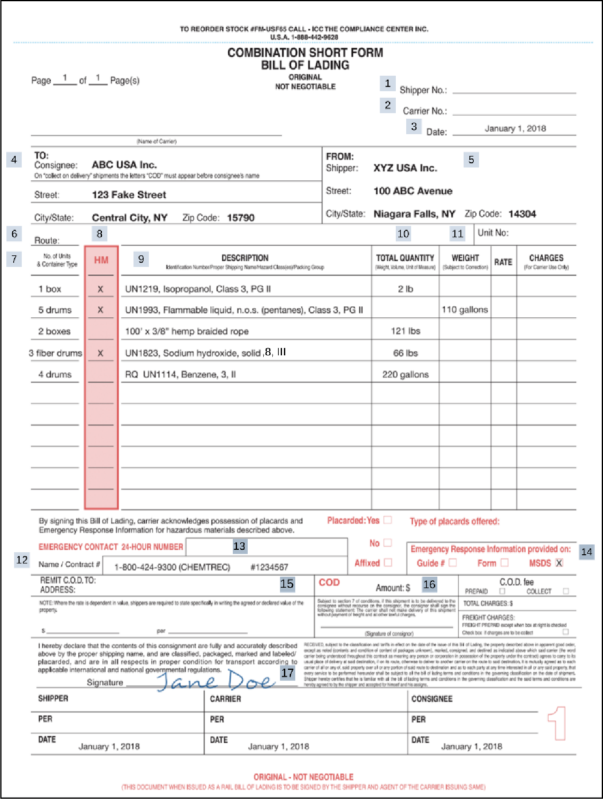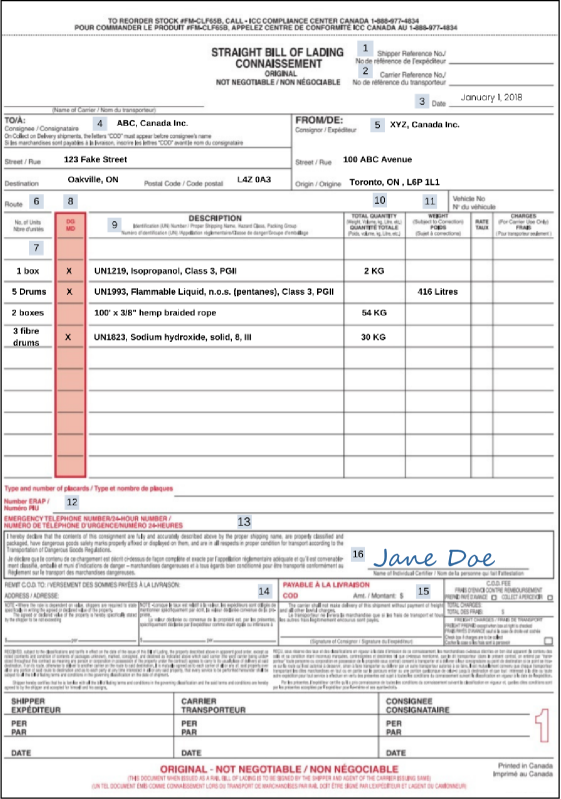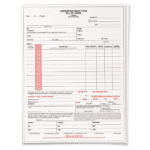
A Bill of Lading is a legal contract between the shipper and carrier. This document that also serves as a shipping receipt contains details on the quantity, type, and destination of the goods.
We’ve highlighted the necessary information required when filling out a Bill of Lading for shipping hazardous materials/dangerous goods by ground in the U.S.A and Canada.
U.S.A Bill of Lading Contents
A Bill of Lading in the U.S.A consists of the following information that needs to be filled out.
- Shipper No: This is the reference number of the party shipping the goods.
- Carrier No: This is the carrier’s reference number.
- Date: The date when the shipment was prepared.
- Consignee Information: All the information relevant to the consignee (party receiving the freight).
- Shipper Information: Information related to the shipper.
- Route: If the place you are shipping the goods does not have an address, you enter the routing address (rural address without a civic address).
- No of Units: The number of packages in the shipment.
- HM: If the goods being shipped are hazardous materials.
- Description: The type of goods being shipped. If the goods are classified as hazardous materials, the shipper needs to include all the required information for the hazardous material.
- Total Quantity: This is the volume of the material being sent. In the U.S.A, this is primarily listed as pounds or gallons.
- Weight: This is the weight of the shipment.
Note: You can provide either the total quantity or weight. - Name/Contact: The name and contact information of the party filling out the Bill of Lading.
- Emergency Contact: The 24-hour number where the emergency contact can be reached.
- Emergency Response Information: This relates to where emergency response information pertaining to the shipment can be found.
- Remit COD To: Address where COD funds are to be sent.
- COD: The Collect on Delivery amount is entered here.
- Signature: Where the person filling out the Bill of Lading signs the document.

Canadian Bill of Lading Contents
- Shipper No: Reference number of the party shipping the goods.
- Carrier No: The carrier’s reference number.
- Date: The date when the shipment was prepared.
- Consignee Information: All the information relevant to the consignee (party receiving the freight).
- Shipper Information: Information related to the shipper.
- Route: If the place you are shipping the goods does not have an address, you enter the routing address (rural address without a civic address).
- No of Units: The number of packages in the shipment.
- DG: If the goods being shipped are dangerous goods.
- Description: The type of goods being shipped. If the goods are classified as hazardous materials, the shipper needs to include all the required information for the hazardous material.
- Total Quantity: This is the volume of the material being sent. In Canada this is primarily listed as kilograms or litres.
- Weight: This is the weight of the shipment.
Note: You can provide either the total quantity or weight. - Number ERAP: If the shipment requires an approved ERAP include the ERAP approval number and activation telephone number.
- Emergency Contact: The 24-hour emergency contact number.
- Remit COD To: Address where COD funds are to be sent.
- COD: The Collect on Delivery amount is entered here.
- Signature: Where the person filling out the Bill of Lading signs the document.

Things to Remember
When filling out a Bill of Lading, it is important to always write the exact name and location in the appropriate fields.
This is a basic guide to filling out a Bill of Lading. Please note that appropriate training is required to complete this document.
At ICC, our Bills of Lading comply with the requirements of Transport Canada’s TDG Part of regulations and DOT 49 CFR 172.200 hazardous materials regulations in the U.S.A.
Contact us today if you have any questions regarding the Bill of Lading.
Stay up to date and sign up for our newsletter!
We have all the products, services and training you need to ensure your staff is properly trained and informed.

|

Shipping Dangerous Goods by Ground |

Shipping Dangerous Goods by Ground |






 ICC USA
ICC USA ICC Canada
ICC Canada